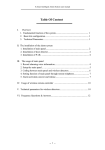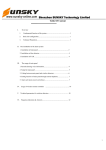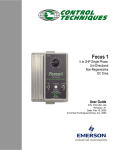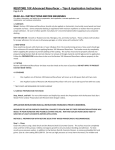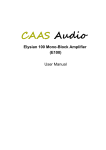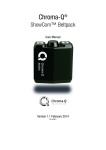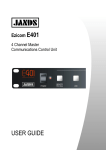Download TX GSM SMS Auto-dial Alarm System Installation and User Manual
Transcript
TX GSM SMS Auto-dial Alarm System Installation and User Manual Product Features: 1. 16 wireless zones, 3 wired zones alarm system, suitable for small to medium size offices and homes. 2. The system uses GSM communication channel, which can be installed in remote areas with GSM coverage. 3. The system supports 900/1800/1900 MHz GSM SIM cards. CDMA or other SIM cards cannot be used. 4. The system can store and dial/SMS 5 phone numbers (15 digits maximum). If an alarm occurs, the numbers stored will be dialled/SMS in order starting with the first phone slot. You can set to dial to monitoring centre, police, or the administrator. 5. By using the remote controllers, you can arm, disarm, or set off the alarm. 6. You can control the system by calling the system anytime, wherever you are. For security reasons, a PIN code must be used for accessing the system. 7. The system supports all kinds of wireless sensors: PIR motion sensors, door/window contact sensors, gas detectors, smoke detectors, panic buttons, and infrared balusters are available. 8. The system supports wired sensors (NO/NC contacts, different wired sensors are available). 9. The system does not need a land telephone line to operate; it is suitable for cottages, houses, shops, and garages. The system only needs a GSM network. 10. With back-up batteries inside, the system can detect AC power cut-off and send SMS alert to the numbers stored. 11. For weak GSM signal area, an external antenna can be used. 12. Two open collector outputs are available to be used according to customer demands. 13. One onboard relay and one open collector speaker output are available for customer application. 14. The system can control home electrical appliances (optional switch box is available). 15. Easy installation and operation. Installation Guide 1. Insert a SIM card to the alarm unit. Press the yellow button next to the card slot gently with a small screwdriver. The SIM card tray will come out. Put the SIM card in correct direction (metal contacts face down) and insert into the system carefully. Attention! Metal contacts of the SIM card must face down. Make sure it is inserted correctly into the unit. **Before inserting SIM card into the alarm unit, use a regular mobile phone to do the following steps: - Set the SIM card PIN code (Password) request to off. - Delete all stored numbers or any message histories 2. Connect the antennas. Attention! Be careful, do not over-tighten the antennas! Connect the antennas before power up the system. 3. Connect the (optional) siren to alarm system. Connect solid black wire to GND port and red (or black-white) wire to SIREN port. If the siren has two white wires instead, connect smooth surface wire to GND and patterned wire to SIREN port. 4. Connecting wired sensors. Three inputs are available to connect wired sensors. Inputs are independent, but they share the same SMS alert message (with zone number indicating which wired zone is triggered at the end of the message). When the alarm is set off via the wired sensors and send out a SMS, it will show Wired Activated (J), (J = 1-3). Sensors can be NO (normally open) or NC (normally close) type. You can connect more than one sensor at one input by connecting the sensors in parallel for NO or in series for NC (< 200Ohms). 5. Connecting switched output devices (Home-appliance Control) The system has two open collector outputs (OUT1 and OUT2), one speaker output (KTLK), and one internal relay (RELAY) controlled by telephone or SMS text commands. Internal onboard relay is activated for two minutes when an alarm occurs and it can be controlled through telephone or SMS text commands. It can be used for example, to turn on a lamp to scare away the thief. The open collector outputs can be used directly, if your equipment allows this, it can operate a relay. Do connect an anti-parallel diode with relay coil for circuit protection. 6. How to distinguish the LED on the main panel? LED during power on: When the unit is supplied with power, the Signal LED first turn on static red colour for about 15 – 20 seconds, this is the time to record any wireless device that is not matched to the system (apply to new accessories that is bought separately). After this period, the Signal LED changes to flashing orange colour, searching for the GSM network. If the system already installed with phone numbers ready for auto-dial when it is being triggered, then the Signal LED will change to FLASHING GREEN colour when it finds the GSM network, indicating CORRECT OPERATION. If there is no phone number in the system, then the Signal LED will change to static green colour, phone number is required for auto-dial. If the alarm system light turns red and flash quickly, means it is being controlled with long-distance function. Signal LED light Green light is ON: Disarm status Green light flash slowly: Arm status Orange light flash slowly: Arm in progress or seaching GSM network during power on Red light is ON: Matching sensors period during power on Red light flash slowly: Alarm triggered Red light flash fast: Receiving call / SMS in remote-distance 7. More explanation on the side connection ports: The GND1, 2, 3 ports – Ground lines; The SIREN port – Siren, audio output, wireless siren transmitter; The RELAY ports – Relay inputs (normally open). It will keep closed for 2 minutes when alarming; KTLK – Loudspeaker output (can use with SX14 loudspeaker); OUT2, OUT1 – Output controls (can use with SXS switch box); IN3, IN2, and IN1 – Inputs for NO/NC wired detectors. Attention! Backup batteries are built in the main unit. Power is present in the main unit even when power supply is not plugged in AC socket or during power cut-off. The user will receive a message “Power off” when the AC power is off. Operating the System 1. Use of remote controller: 1. Arming button (closed padlock) – press it to arm system. Wired siren will give a short ring. 2. Disarm button (open padlock)– press it to disarm system. Wired siren will give two short rings. 3. Panic button (bell) – press it and wired or wireless siren will start to ring continuously, alarming the others. Using phone call or SMS text message to control the GSM alarm system : Calling the alarm system: after one ring unit will answer and a beep will be heard. You have to input the password followed by “ # ” key (Default password is 123456). System responds with beep and now you can send several commands and change some settings. Some of the settings can only be set by SMS messages (Command 7, 11, 17-23). Sending SMS text message: text message should start with password# and followed by system command. If setup is completed, user will receive a confirmation SMS message. 2. System Commands: (1) Arm/Disarm: 1#1# (Arm) 1#0# (Disarm) (2) Alarm immediately on spot: 3#1# (On) 3#0# (Off) (3) Immediate site monitoring: 4#1# (On) 4#0# (Off) (4) Alarm with siren: 11#1# (On) 11#0# (Off) (5) Alarm with SMS: 12#1# (On) 12#0# (Off) (6) Alarm with dial phone: 15#1# (On) 15#0# (Off) (7) Require each zone’s status of arm or disarm: 30## (8) Change the password: 31#code (6 digit)# (Default password: 123456) Note: It is wise to change PIN code at first login in alarm system. (9) Partial zone arm: 38# (1~16 wireless zone, 21~23 wired zone)# (10) Partial zone disarm: 39# (1~16 wireless zone, 21~23 wired zone)# (11) Require the telephone No: 50## (12) Edit the first phone number: 51# Phone number (0~15bit)# (13) Edit the second group phone number: 52# Phone number (0~15bit)# (14) Edit the third group phone number: 53# Phone number (0~15bit)# (15) Edit the fourth group phone number: 54# Phone number (0~15bit)# (16) Edit the fifth group phone number: 55# Phone number (0~15bit)# (17) Require the content of the SMS: 80## (18) Edit the first zone alarm SMS: 81#the content of SMS (0~24 letters)# (19) Edit the second zone alarm SMS: 82#the content of SMS (0~24 letters)# (20) Edit the third zone alarm SMS: 83#the content of SMS (0~24 letters)# (21) Edit the “I” alarm SMS: 84#the content of SMS (0~24 letters)#, (I = Zone 4~16) (22) Edit the wired zone alarm SMS: 85#the content of SMS (0~24 letters)#, (Wired Zone 1~3) (23) Require the status of outlet: 90## (24) Set the OUT1: 91#1# (Outlet 1 high) 91#0# (Outlet 1 low) (25) Set the OUT2: 92#1# (Outlet 1 high) 92#0# (Outlet 1 low) (26) Set the loudspeaker KTLK: 93#1# (Speaker on) (27) Set the RELAY : 94#1# (Relay close) 93#0# (Speaker off) 94#0# (Relay open) (28) Set input type for IN1: 95#1# (NC Type) 95#0# (NO Type) (29) Set input type for IN2: 96#1# (NC Type) 96#0# (NO Type) (30) Set input type for IN3: 97#1# (NC Type) 97#0# (NO Type) 3. How to setup the alarm phone numbers (5 groups) and the content of SMS alerts (5 groups)? 1. User can send a SMS to set the alarm phone number, and the SMS command should be sent as follow: password#operating code 51-55#phone number# Send SMS: 123456#51#1st phone number#, means storing 1st phone number. Send SMS: 123456#52#2nd phone number#, means storing 2nd phone number. Send SMS: 123456#53#3rd phone number#, means storing 3rd phone number. Send SMS: 123456#54#4th phone number#, means storing 4th phone number. Send SMS: 123456#55#5th phone number#, means storing 5th phone number. Send SMS to delete a stored phone number: 123456#51##, means deleting the 1st phone number. Other phone numbers can be deleted using similar method but changing to 52##, 53##, 54##, and 55##. Send a SMS to acquire the phone numbers stored: 123456#50##. 2. The alarm system has fixed 5 SMS alerts, alert No.1-3 correspond to wireless zones (1-3), alert No.4 corresponds to wireless zones (4~16), alert No.5 corresponds to the wired zones (1-3). When wireless Zone 1 is triggered: Wireless Activated (1). When wireless Zone 2 is triggered: Wireless Activated (2). When wireless Zone 3 is triggered: Wireless Activated (3). When wireless Zone I is triggered: Wireless Activated (I) (I = 4-16). When I1, I2, or I3 wired zone is triggered: Wired Activated (J) (J=1-3). User can send a SMS to replace the content of the alarming SMS: Send SMS: 123456#81#Front Door Open#, replaces the “Wireless Activated (1)” for alert No.1. Send SMS: 123456#82#Back Door Open#, replace the “Wireless Activated (2)” for alert No.2. Send SMS: 123456#83#Fire Alarm#, replace the “Wireless Activated (3)” for alert No.3. Send SMS: 123456#84#Other Sensors#, replace the “Wireless Activated (I)” for alert No.4. Send SMS: 123456#85#Wired Sensors#, replace the “Wired Activated (J)” or alert No.5. Acquire the content of SMS: 123456#80## Note: the content of SMS edited cannot exceed 24 letters. Advanced Instructions (Only performed under technical guidance) 1. Resetting the system. NOTICE! Resetting the system will cause all coded information and messages to be lost. System will be loaded with basic factory settings. The passwords will be back to the default value 123456. You must code/register all wireless sensors again after reset. Reset procedures: - System must be disarmed and then power off. - Press and hold the reset button, meanwhile connect a 12Vdc supply to the alarm system. - Release the reset button, the alarm LED will flash once. - Wait until the status / signal LED changes to green colour. Now system is reset and back to factory settings (the password is 123456). 2. How to add new sensors to the alarm system (Registering wireless sensors with control unit) Sensors and remote controls delivered in kit are already added (registered) to the system. Plug in DC 12V power supply to the alarm system. If the alarm system needs to add new sensors, such as PIR motion sensors, remote controls, and so on, you can do so within the 20 seconds after the power is on. After applying 12Vdc to the system, when signal LED light is in red colour, trigger the sensor you want to match to the system to emit a signal. If the main unit picks up this signal, the wired siren will give short rings and signal LED will flash in red. If no sensor is triggered within 20 seconds, the system starts to search for GSM network and signal LED flashes in orange. Test all sensors after adding to the system and repeat above procedures if more sensors need to be added. Maximum number of wireless zones that can be coded by the system is 16. But you can register countless wireless sensors by grouping sensors to the same zone (same address code, 8-digit jumper setting in sensors). 3. How to cancel the lost remote controllers in the alarm system If a remote sensor is lost, the user needs to clear this remote controller. Press the RESET key on the back of the alarm system and then plug in power. The status / signal light flashes once meaning the alarm system reset successfully. After resetting the alarm system, all setup come back to the time when it came from the factory. The origin password is 123456. Repeat the add sensor instructions above to match back other sensors and remotes. 4. How to test the alarm system function When the power is on and turns into the disarm status, users can arm it through remote controller (arm key) or by sending a SMS (Password#1#1#) When the alarm system is in arm status, the red light flashes slowly if the wired inputs trigger the alarm or wireless sensors trigger the alarm. 1. If the SMS alarming function is enabled, the system will send the corresponding SMS based on the trigger port (wired IN1, wired IN2, wired IN3, wireless sensors). It will then call the stored numbers. If the SMS alarming function is disabled, it will just call the stored number directly. 2. After the alarm is set off and the system calls you, you do not need to input the password again to control the system. Standard components and optional available components Additional wireless products (optional): Optional sensors/detectors are available separately. They include remote controllers, wireless PIR, wireless gap sensor, wireless gas detector, wireless smoke detector, panic button, wireless sirens, etc. Please contact us for full details on all the supported wired / wireless sensors. Technical Parameters GSM Alarm Module Operating voltage: DC12V Average power: AC/DC exchanger 12V Wireless receiving distance: ≥ 80m open space Operating Frequency: 433.92 MHz GSM Frequency: 900 / 1800 / 1900 MHz Outer Alarm Siren Volume: 110 dB Working Condition: Temperature -10 °C to 40 °C Working Humidity: 10% - 90% rh Wireless Gap Detector (Door / Window Contact) Power Supply: DC12V (inner 12V battery) Static Current: ≤ 20 mA Transmission Current: ≤ 15mA Transmission Frequency: 433 MHz ± 0.5 MHz Transmission Distance: No obstacle 80m Internal Distance: 15mm Working Condition: Temperature 0 °C to 45 °C Working Humidity: 10% - 90% rh Wireless PIR Detector Power Supply: DC9V (inner 9V battery) Static Current: ≤ 100 mA Transmission Current: ≤ 20mA Transmission Frequency: 433 MHz ± 0.5 MHz Transmission Distance: No obstacle 80m Detective Speed: 0.3 - 3m/s Detective Distance: 5 - 12m Detective Range: Horizontal 110° Vertical 60° Working Condition: Temperature 0 °C to 45 °C Working Humidity: 10% - 90% rh Remote Control Power Supply: DC12V (inner DC12V battery) Transmission Current: ≤ 15mA Transmission Frequency: 433 MHz ± 0.5 MHz Transmission Distance: No obstacle 80m Troubleshooting Section GSM Problem - The light keeps flashing orange meaning the GSM network has not been established. 1. The SIM card circuit side should face downwards, slide the sim card holder into the slot of the main unit carefully to make sure the card has the contact with the main unit circuit board. 2. The SIM card should use 900/1800/1900 MHz GSM Band. Only use GSM SIM card, not CDMA or 3G. 3. Make sure the SIM card has NO password, NO phone number, or any message history in it. 4. Apply the power with the 12V 2A power adapter we supplied and connect it to the main supply. 5. Use the antenna; this is for the GSM reception. 6. If possible try with another unlocked SIM card (different company), or try the alarm at another location to check GSM reception. If the alarm has established a GSM network, then the signal LED should change to green colour. Sensors / Remotes - The sensor does not trigger the alarm system 1. Check the sensor battery. 2. Re-match the sensor to the system according to adding a new sensor section.













